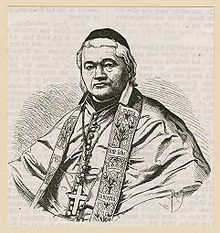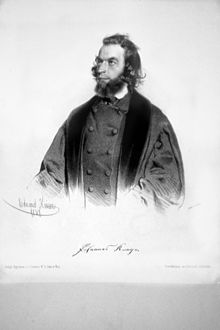- German Catholics
-
The German Catholics (Deutschkatholiken) were a schismatic sect formed in December 1844 by German dissidents from the Roman Catholic Church, under the leadership of Johannes Ronge.
Contents
History
Johannes Ronge, a Roman Catholic priest in Silesia, published a vigorous attack upon Wilhelm Arnoldi, bishop of Trier since 1842, in the 15 October 1844 issue of the Sächsische Vaterlandsblätter for having ordered (for the first time since 1810) the exposition of the alleged seamless robe of Jesus, an event that drew countless pilgrims to the cathedral. The Bishop had proclaimed that the artifact had healing powers.
Ronge, who had formerly been chaplain at Grottkau, was then a schoolmaster at Laurahütte near the Polish border. The article made a great sensation, and led to Ronge’s excommunication by the chapter of Breslau in December 1844. The ex-priest received much public sympathy, and a dissenting congregation calling itself the "New Catholics" was soon formed at Breslau. Within less than a year, the group grew to over 8,000 members.
The Bible was made the sole rule, barring all external authority. Within a few weeks similar communities were formed at Leipzig, Dresden, Berlin, Offenbach am Main, Worms, Wiesbaden and several other locations; and at a council convened at Leipzig at Easter 1845, 27 congregations were represented by delegates, of whom only two or at most three were in clerical orders.
Ronge organized the "New Catholics" as principally a democratic organization. He ended the rule of celibacy for priests, excommunication, oral confessions, indulgences, canonization and invocation of saints, use of the Latin language in divine service, prohibition of mixed marriages, the supremacy of the pope and other practices of the Roman Catholic Church. He married Bertha Mayer, sister of Carl Schurz's wife, Margarethe. Many churches followed his example and the "New Catholics" grew rapidly. Ronge had also garnered support from Robert Blum, a newspaper publisher in Saxony. Blum published writings of the new movement and helped to organize it.
Many of the "New Catholics" were involved in politics. Their membership dominated the parliament in Worms. With their view of "rational religion", the council proclaimed "that the sole basis of Christian faith was to be in the Bible, interpreted "by each for himself in the light of reason". They were later forced to change their name from "New Catholics" to "German Catholics". A Protestant group analogous to the New Catholics was the Friends of the Light. In 1849, these two groups combined to form the Free Congregations.
Of the German Catholic congregations that had been represented at Leipzig some manifested a preference for the fuller creed of the Christian Catholic sect based in Schneidemühl, but a great majority continued to accept the comparatively rationalistic position of the Breslau school. The number of these rapidly increased, and the congregations scattered over Germany numbered nearly two hundred. External and internal checks, however, soon limited this advance. In Austria, and ultimately also in Bavaria, the use of the name "German Catholic" was officially prohibited, with that of "Dissidents" being substituted, while in Prussia, Baden and Saxony the adherents of the new creed were put under various disabilities, being suspected of both undermining religion and encouraging the revolutionary tendencies of the age. Ronge himself was a foremost figure in the troubles of 1848; after the dissolution of the Frankfurt Parliament he lived for some time in London, returning in 1861 to Germany. He died in Vienna on 26 October 1887.
As of 1911, there were only about two thousand strict German Catholics, all in Saxony. The movement was superseded by the Old Catholic Church.
Beliefs
German Catholics adhered to a very simple creed, in which the chief beliefs were:
- God the Father, creator and ruler of the universe.
- Jesus Christ the Saviour, who delivers from the bondage of sin by his life, doctrine and death.
- The operation of the Holy Ghost.
- A holy, universal, Christian church.
- Forgiveness of sins and the life everlasting.
Related movements
Even before the beginning of the agitation led by Ronge, another movement fundamentally distinct, though in some respects similar, had been originated at Schneidemuhl, Posen, under the guidance of Johannes Czerski, also a priest, who had come into collision with the church authorities on the then much discussed question of mixed marriages, and also on that of the celibacy of the clergy. The result had been his suspension from office in March 1844; his public withdrawal, along with twenty-four adherents, from the Roman communion in August; his excommunication; and the formation, in October, of a "Christian Catholic" congregation which, while rejecting clerical celibacy, the use of Latin in public worship, and the doctrines of purgatory and transubstantiation, retained the Nicene theology and the doctrine of the seven sacraments. Czerski had been at some of the sittings of the German Catholic council of Leipzig; but when a formula somewhat similar to that of Breslau had been adopted, he refused his signature because the divinity of Christ had been ignored, and he and his congregation continued to retain by preference the name of "Christian Catholics", which they had originally assumed.
In 1859 some of the German Catholics entered into corporate union with the Free Congregations, an association of free-thinking communities that had since 1844 been gradually withdrawing from the orthodox Protestant Church, when the united body took the title of The Religious Society of Free Congregations. Before that time many of the congregations which were formed in 1844 and the years immediately following had been dissolved, including that of Schneidemuhl itself, which ceased to exist in 1857.
References
 This article incorporates text from a publication now in the public domain: Chisholm, Hugh, ed (1911). "German Catholics". Encyclopædia Britannica (11th ed.). Cambridge University Press. This work in turn cites the following four items as references and further reading:
This article incorporates text from a publication now in the public domain: Chisholm, Hugh, ed (1911). "German Catholics". Encyclopædia Britannica (11th ed.). Cambridge University Press. This work in turn cites the following four items as references and further reading:
- G. G. Gervinus, Die Mission des Deutschkatholicismus (1846)
- F. Kampe, Das Wesen des Deutschkatholicismus (1860)
- Findel, Der Deutschkatholicismus in Sachsen (1895)
- Carl Mirbt, in Realencyklopadie fur Protestantische Theologie und Kirche, founded by J. J. Herzog, 3d ed. by A. Hauck, Leipzig (1896-1909) iv. 583.
 "German Catholics". The American Cyclopædia. 1879.
"German Catholics". The American Cyclopædia. 1879.
See also
External links
Categories:- Christianity in Germany
- Revolutions of 1848
- Christian denominations founded in Germany
Wikimedia Foundation. 2010.


